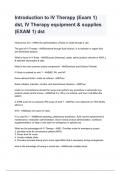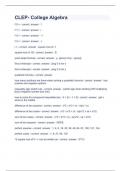Introduction to IV Therapy (Exam 1)
dst, IV Therapy equipment & supplies
(EXAM 1) dst
Intravenous (IV) - ANSIs the administration of fluids or meds through a vein
The goal of IV Therapy - ANSAchieved through fluid infusion, is to maintain or regain fluid
and electrolyte balance
What is found in IV fluids - ANSGlucose (Dextrose), water, saline (sodium chloride or NACL),
& selected electrolytes & salts
What is the most common solute components - ANSDextrose and Sodium Chloride
IV fluids is ordered by who ? - ANSMD, PA, and NP
Nurse delivers fluids / meds as ordered - ANSTrue
Nurse initiates, maintain, monitor, and discontinues infusions - ANSTrue
Under no circumstances should the nurse ever perform any procedure or administer any
product unless he/she knows - ANSWhat it is, Why it is ordered, and how it will affect the
patient
Is IVPB a part of a Louisiana LPN scope of work ? - ANSYes, but it depends on if the facility
allows it.
KVO - ANSkeep vein open (IV rate)
IV is used for ? - ANSBlood sampling, phlebotomy transfusion, fluid volume replacement &
maintenance, medication administration, blood / blood product administration, nutritional
supplementation, to keep a vein open for emergency or special use
What are the advantages of IV Therapy - ANS1. Provides route for emergency access
2. provides route for unconscious patient (NPO)
3. Saves time for nurse
4. Avoids multiple sticks
5. Provides accurate dosing and a more rapid effect that is necessary during emergencies
what is the advantage of having a central line - ANSAvoids multiple sticks
, Disadvantages of IV therapy - ANSLocal discomfort, infiltration, sepsis, thrombosis, fluid
overload, allergic reactions, transmission of Hep B/C & HIV
What is the 7 rights of medication administration ? - ANSRight patient, right drug, right dose,
right route, right time, right technique, and right documentation
How long does it take for IV medications to absorb into the body ? - ANS5 - 10 minutes
IV medication errors are very serious and due to what ? - ANSRapid absorption
IV medications have a ___________ time frame before and after in which the medication
must be give. - ANS30 minute
If it is not documented, it's is not what ? - ANSDone
What are the 3 checks to medication administration? - ANS1. Read label as you pull it from
its location
2. Read label we comparing it with the MAR
3. Read label again before giving drug
If a medication error occur, what must the nurse never do ? - ANSNever ignore or try to
conceal it, to conceal it is dishonest and a breach of duty owed to the patient.
What must a nurse do for an medication error ? - ANS1. Notify MD
2. Complete appropriate forms and documentation
3. Follow employer protocol regarding medication errors
4. Patient has right to know about the error
How is a medication error documented ? - ANSUsually an incident report, never in the
medical record
When documenting the start of an IV, what must the nurse document ? - ANSSolution
ordered, gauge size (Jelco), site, dressing type, patients response, time, rate of infusion, use
of infusion device, and teaching
Joint commission for accreditation of healthcare organizations (JCAHO) - ANSAccredits
healthcare facilities to ensure quality patient care. And establishes standards published in
National patient safety goals
What are JCHAO safety goals, that apply to tye practice of IV therapy ? - ANS1. Improve
accuracy of patient identification
2. Improve effectiveness of communication among care givers
3. Improve safety of using medications
7. Reduce the risk of infections associated with health care
8. Reconcile medications accurately and completely across the continuum of care





